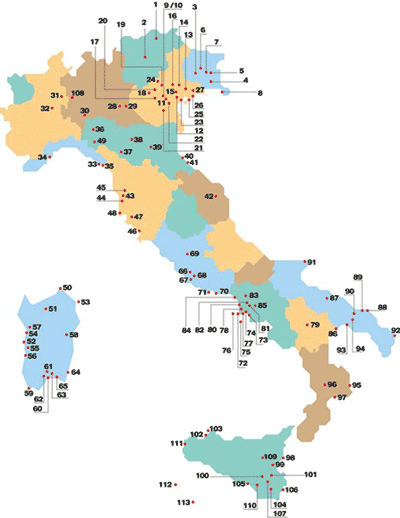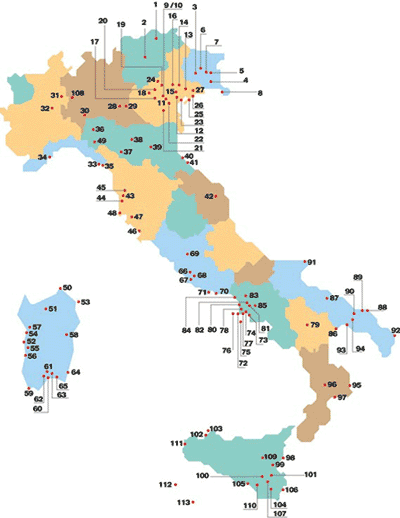The Foreign Policy of a banana republic
By postfataresurgo for The Saker Blog
Many decades of corruption and meddling by US intel agencies have turned Italy into a pitiful vassal state. The country is dotted with US bases making it, as some wits have pointed out, the largest aircraft carrier in the US fleet. Pervasive American presence is now part of the new ITALIAN normal.
[dropcap]W[/dropcap]hat is essentially a Banana Republic? Regardless of its agricultural products, whether it’s bananas or broccoli, the definition can be applied to a country that is politically unstable on a permanent basis and/or a country whose sovereignty exists only on paper, being a de facto colony of a bigger power.
There is a joke going around Italy these days, after the latest Iranian developments: Italy doesn’t really need a foreign minister, since the position is already taken by a guy named Mike Pompeo, whose origins are, after all, Italian. Pompeo seemingly spent two days on the phone doing his best to inform European allies of what happened, but didn’t have time for a call to his Italian counterpart. Seriously, why bother? Italy’s new foreign minister is new on the job, doesn’t speak English let alone a basic knowledge of world geography, why would anyone bother wasting his time trying to have a professional chat with such a world class diplomat named Luigi Di Maio?
Di Maio chose to become foreign minister after having served as deputy prime minister (a joint position held with Matteo Salvini) and Minister of Economic Development in the former government (2018-2019). His credentials to become foreign minister are nonexistent, to say the least. Matteo Salvini, now the leader of opposition parties – has called the current Italian government “the worst in Italian history”. He may be right about that but his immediate reaction after Soleimani’s assassination –clapping hands on command, calling Soleimani a terrorist, unconditionally aligned with the US – was also that of a banana republic lackey.
A somewhat more dignified and diplomatic comment has come from Giorgia Meloni, who said that the whole situation doesn’t require “cheering like fans in a football stadium” and requires serious ponderation. Meloni’s right-wing party (Fratelli d’Italia) is currently seeing a slow but steady increase in polls, certainly due to her leadership, recognized also by international press such as The Times as among the most influential leaders for 2020.
Comments aside, on the wake of an event that brought the world on the brink of a war, no Italian political leader would dare say anything about Italy’s real condition as a meaningless periphery of the Empire, occupied by well over 100 US military installations of various size, shape and purposes, including atomic stockpiles. These installations are a de facto extraterritorial pieces of US within Italy, thanks to peace treaties that go back to 1947, and still very much in existence. Italy’s presence in NATO is completely subservient to US interests and members of the Italian armed forces are present in various numbers around the world wherever the Empire deems them useful, such as Afghanistan, Iraq and Lebanon with exorbitants costs for the Italian taxpayer.
No Italian political figure, present or immediately future, represents a possible critic to such a state of affairs. Then again, every time an Italian PM shows signs of – say – independent initiative, he’s quickly brought back to obedience, although we must say the methods have changed over time. The latest example was Berlusconi’s cooperation and friendship treaty with Libya, signed with Gheddafi in 2008. Both leaders were to be wiped out of the scene within three years, albeit with very different methods: bombs for the African dictator, an overnight downrating of the Italian economy for the Milanese tycoon.
Rewind back to the mid 80’s, when Italy’s was enjoying a robust economy and its own currency. In October 1985 the Sigonella standoff proved itself to be the last act of sovereignty of Italy, thanks to then PM Bettino Craxi, who was then rewarded for his act of bravery with a forced exile in Tunisia when in the early 90’s a well orchestrated judiciary coup commonly known as Mani Pulite brought an entire political generation to its knees and with that the end of Italy’s Prima Repubblica.
Back to 1978, our memory goes to Aldo Moro, whose body was delivered in the trunk of a car in the center of Rome courtesy of CIA infiltrated Red Brigades. Moro, who had been openly threatened by Kissinger for his attempts to have the Italian Communist Party (PCI) as member of the government’s coalition, had pursued in well over a decade a low profile foreign policy in the best interest of Italy, with a constant dialogue with Arab countries and a secret pact with Arafat’s PLO which kept Italy “protected” from possible Palestinian terrorists.
Moro was a low-key figure, quite the opposite from flamboyant maverick Enrico Mattei who worked tirelessly to make Italy energy independent and its state oil company ENI a leading player in a world dominated by US and British oil companies. Mattei was appointed after the war with the task of liquidating a little known state enterprise, AGIP, created by the Fascist regime. Instead, recognizing the potential of the company as a state asset in appropriating oil sources around the world, he reorganized it under the new name Ente Nazionale Idrocarburi, introducing –among other things – the principle whereby the country that owned exploited oil reserves would receive up to 75% of the profits.
Needless to say, Mattei had many enemies around the world, and his death sentence was just a matter of time. In October 1962 his company jetplane exploded in flight as it was about to land in Milan coming from Sicily. Official enquiries immediately declared it was an accident. It took at least three decades to reclassify the accident as homicide by a bomb that had been hidden in the plane. We now know that it was – once again – the Mafia that acted on behalf of “foreign powers”.
Mattei, Moro and Craxi had been ordinary men who found themselves appointed in positions of high power. Each one had his different style, his many shortcomings and each one made mistakes during their career. But one thing they had in common: they worked in the best interest of their country, and they all payed for it. By comparison, today’s political scene in Italy is made of clueless invertebrates whose interests are only of sheer political survival.
Luigi di Maio may be Italy’s foreign minister for the next few months, or years. Regardless, he represents the nothingness of the country in the global scene. In 1911, a then young country formed only 50 years before claimed Libya from a decaying Ottoman empire. A century later, the Ottoman empire is back on the scene, and claims – together with other actors – to call the shots on the doorsteps of a decaying banana republic. What goes around, comes around.
Addendum
This material comes from The News Analised (Le Notizie Analizzate)
(US Military Bases in Italy (there are over 100)
Click the link below as indicated.
[bg_collapse view="link-inline" color="#4a4949" expand_text="American Bases in Italy- click here for details" collapse_text="Show Less" ]
Some Major Bases:
-
- Aviano Air Base, Pordenone
-
- Caserma Ederle, Vicenza
-
- San Vito Dei Normanni Air Station, near Brindisi
-
- Naval Air Station Sigonella, near Catania, Sicily
- Camp Darby, near Pisa and Livorno
Sigonella has been, and possibly still is used as a transfer station for persons of interest in the war on terror (extraordinary rendition). (Source: BBC)
From http://www.kelebekler.com/ (My translation):

Trentino Alto Adige
1. Cima Gallina [Bz]. Communication Station and USAF radar.
2. Monte Paganella [Tn]. USAF Telecommunication Station.
Friuli Venezia Giulia
3. Aviano [Pn]. The biggest advanced base, nuclear deposits and center for USAF telecommunications in Italy [at least 3000 troops and American civilians]. In the base there are USAF operative forces ready for combat [a group of fighter bombers] that were used in the strafings in Bosnia. Moreover, the 16th Air Force and the 31st Fighter Wing and not to mention a Marines squadron of F-18s. It is presumed that the base holds nuclear bombs in an underground bunker, whose construction was authorized by Congress. In the Aviano area base in the Pordenone region there are permanent deployments since 1994 of the 31st Fighter Wing, equiped with 2 squadrons of F-16s [in the war against Yugoslavia in 1999, in 78 days there were 9000 missions: a record] and the 16th Air Force. The latter was equipped with F-16 and F-15 fighters, and has the task, under the U. S. European Command, to not only plan and to lead operations of aerial combat in southern Europe, but also in Middle East and North Africa. It operates, with a staff of 11.500 military and civilians, from two main bases: Aviano, where one finds the General Division, and the Turkish base of Incirlik. The latter base will be the main base for the aerial offensive against northern Iraq, but the use of planes of the 16th Air Force will be planned and directed by the General Division of Aviano.
5. Rivolto [Ud]. USAF Base.
6. Maniago [Ud]. USAF shooting range.
7. San Bernardo [Ud]. US Army munitions depot.
8. Trieste. US Naval Base.
Veneto
9. Camp Ederle [Vi]. General Division of NATO and command of SETAF of the US Army, which controls American forces in Italy, Turkey, and Greece. In this base, there are land troops normally in Italy: an air transported battalion, an artillary battalion with nuclear capability, three companies of the kind. Important telecommunication station. The American military and civilians that operate at Camp Ederle should number about 2000.
10. Vicenza: SETAF (Southern European Task Force) command. 5th Allied Tactical Air Force. Probable depot for nuclear war heads.
11. Tormeno [San Giovanni a Monte, Vi]. Arms and munitions depot.
12. Longare [Vi]. Important arms depot.
15. Istrana [Tv]. USAF base.
16. Ciano [Tv]. US telecommunication and radar center.
17. Verona. Air Operations Center [USAF] and NATO SETAF base. USAF telecommunication center.
23. Venezia. US Naval base.
24. Sant'Anna di Alfaedo [Pd]. US Radar base.
25. Lame di Concordia [Ve]. US telecommunication and radar base.
26. San Gottardo, Boscomantivo [Ve]. US telecommunication center.
27. Ceggia [Ve]. US radar center.
Lombardia
28. Ghedi [Bs]. USAF base, communication station and nuclear bomb depot.
108. Sorico [Co]. NSA antenna.
Piemonte
32. Candelo-Masazza [Vc]. USAF and US Army training, with NATO coverage.
Liguria
33. La Spezia. SACLANT (Supreme Allied Commander, Atlantic) Anti-submarine center. [see 35].
34. Finale Ligure [Sv]. Telecommunication station of the US Army.
35. San Bartolomeo [Sp]: Center of research for submarine warfare. Composed of 3 structures. First of all is SACLANT, an affiliate of NATO that is not indicated on any map of the Atlantic Alliance. It would have been better if SACLAT hadn't specified precisely marine research: in a dossier prepared by the Federation of Rifondazione Comunista, it says that "occupation of areas that mirror the water for military requirements of the Italian state and not a shelter for the 6th US Fleet." Then there is Maricocesco, an agency that resupplies the navy. Lastly, Mariperman, the permanent commission for experimenting with war materials, composed of 500 people and 11 institutes [of artillary, munitions, and missles, to the underwater crews].
Emilia Romagna
36. Monte San Damiano [Pc]. USAF base with NATO coveraege.
37. Monte Cimone [Mo]. US telecommunication station with NATO coverage.
40. Rimini. US logisitcal group for the activation of nuclear bombs.
41. Rimini-Miramare. US telecommunication center.
42. Potenza Picena [Mc]. US radar center with NATO coverage.
Toscana
43. Camp Darby [Pi]. SETAF has the biggest logistical depot in the Mediterranean [between Pisa and Livorno], with about 1400 men, where the 31st Munitions Squadron is. Here, in 125 underground bunkers, is stocked a strategic reserve for the US Army and aeronautics, estimated at more than a million and a half munitions. Closely connected through a web of canals near the port of Livorno, across Navicelli Canal, there is a base for refueling the navy units stationed in the Mediterranean. The 8th Support Group and US Army base for supporting the American forces south of the Po River, the Mediterranean, the Gulf, North Africa, and Turkey.
45. Pisa [aeroporto militare]. Irregular USAF base.
46. Talamone [Gr]. Irregular US Navy base.
47. Poggio Ballone [Gr]. Between Follonica, Castiglione della Pescaia and Tirli: US radar center with NATO coverage.
48. Livorno. US naval base.
49. Monte Giogo [Ms]. US telecommunicatino center with NATO coverage.
Sardegna
50. La Maddalena - Santo Stefano [Ss]. US atomic base, submarine base, naval squad in support of American aircraft carrier "Simon Lake".
52. Sinis di Cabras [Or]. NSA data processing center.
54. Torre Grande di Oristano. NSA radar base.
55. Monte Arci [Or]. US telecommunication station with NATO coverage.
56. Capo Frasca [Or]. US heliport and system radar.
57. Santulussurgiu [Or]. USAF telecommunication station with NATO coverage.
58. Perdasdefogu [Nu]. Experimental missle base.
59. Capo Teulada [Ca]. From Capo Teulada to Capo Frasca [Or], approximately 100 km of coast, 7,200 hectares of land and more than 70,000 hectares of "off limits" zones: shooting range for navy and aerial practices for the US 6th Fleet and NATO.
60. Cagliari. US naval base.
61. Decimomannu [Ca]. US airport with NATO coverage.
62. Aeroporto di Elmas [Ca]. USAF air base.
63. Salto di Quirra [Ca]. Missile shooting range.
64. Capo San Lorenzo [Ca]. Training zone for the US 6th Fleet.
65. Monte Urpino [Ca]. US and NATO munitions depot.
Lazio
66. Roma. Command for the Central Mediterranean for NATO and the US interforce logistic coordination. NATO station.
67. Roma Ciampino [aeroporto militare]. Irregular USAF base.
68. Rocca di Papa [Rm]. US telecommunication station with NATO coverage, with probable connection to the underground installations at Monte Romano.
69. Monte Romano [Vt]. US Army shooting range.
70. Gaeta [Lt]. Permanent base of the 6th Fleet and of the naval squadron that supplies the aircraft carrier "La Salle".
71. Casale delle Palme [Lt]. NATO telecommunications school under US control.
Campania
72. Napoli. Command of the Marines Security Force. US submarine base. Command for the USAF in the Mediterranean. Port normally employed by the civil units and US military. It is estimated that annually from Naples and Livorno 5000 military container trips are made.
75. Ischia [Na]. US telecommunication antenna with NATO coverage.
76. Nisida [Na]. US Army base.
77. Bagnoli [Na]. Seat of the biggest center of coordination of the US Navy in all telecommunication activities, command and control of the Mediterranean.
78. Agnano [in the vicinity of the famous race course]. US Army base.
80. Licola [Na]. US telecommunication antenna.
81. Lago Patria [Ce]. US telecommunication station.
82. Giugliano [vicinanze del lago Patria, Na]. Statcom Command.
83. Grazzanise [Ce]. Irregular USAF base.
84. Mondragone [Ce]: US and NATO Center of Command for underground anti-atomic weapons, where they want to marry the US and NATO commands in case of war.
85. Montevergine [Av]: Communication station for the US.
79. Cirigliano [Mt]. Command for the US Naval Forces in Europe.
86. Pietraficcata [Mt]. Center for telecommunications for USA and NATO.
Puglia
87. Gioia del Colle [Ba]. US air base and technical support.
88. Brindisi. US Naval Base.
89. Punta della Contessa [Br]. US and NATO shooting range.
90. San Vito dei Normanni [Br]. Would have been the home to a thousand American troops of the 499th Expeditionary Squadron. Secret service base. Electronics Security
Group [NSA].
91. Monte Iacotenente [Fg]. Base for the complex radar NADGE (NATO Air Defense Ground Environment).
92. Otranto. US radar station.
93. Taranto. US Naval Base. Storage for USA and NATO.
94. Martinafranca [Ta]. Radar Base USA.
95. Crotone. Telecommunication station and radard for USA and NATO.
96. Monte Mancuso [Cz]. Telecommunication station for USA.
97. Sellia Marina [Cz]. Telecommunications center for the US with NATO coverage.
Sicilia
98. Sigonella [Ct]. Main land base of the Navy in the central Mediterranean, logistic support of the 6th Fleet [about 3400 between military and civilians]. Beyond US Navy unit, it accommodates various tactical squadrons of the USAF: helicopters of the type HC-4, hunting Tomcat F14's and A6 Intruders, groups of F-16 and F-111 equipped with nuclear bombs of the B-43 type, from more than 100 kilitons each.
99. Motta S. Anastasia [Ct]. Telecommunication station for USA.
100. Caltagirone [Ct]. Telecommunication station for USA.
101. Vizzini [Ct]. Various US storage. Note: a non-comissioned officer of the aereonautical military has written to us, specifying that there are no US installations in this Italian military base.
103. Isola delle Femmine [Pa]. Munitions depot for the US and NATO.
104. Comiso [Rg]. The base will be dismantled.
105. Marina di Marza [Rg]. Telecommunication station for USA.
106. Augusta [Sr]. Base of the 6th fleet and munitions depot.
107. Monte Lauro [Sr]. Telecommunication station for USA.
109. Centuripe [En]. Telecommunication station for USA.
110. Niscemi [Cl]. NavComTelSta base [US Navy communication].
111. Trapani. USAF Base with NATO coverage.
112. Isola di Pantelleria [Tp]: Telecommunication center for the US Navy, air base and NATO radar.
113. Isola di Lampedusa [Ag]: US Coast Gaurd Base. Center for eavesdropping (listening) and communications for the NSA.
[/bg_collapse]

[premium_newsticker id="211406"]
Read it in your language • Lealo en su idioma • Lisez-le dans votre langue • Lies es in Deiner Sprache • Прочитайте это на вашем языке • 用你的语言阅读
[google-translator]
[/su_spoiler]
THE DEEP STATE IS CLOSING IN
![]() The big social media —Google, Facebook, Instagram, Twitter—are trying to silence us.
The big social media —Google, Facebook, Instagram, Twitter—are trying to silence us.

THIS WORK IS LICENSED UNDER A Creative Commons Attribution-NonCommercial 4.0 International License




